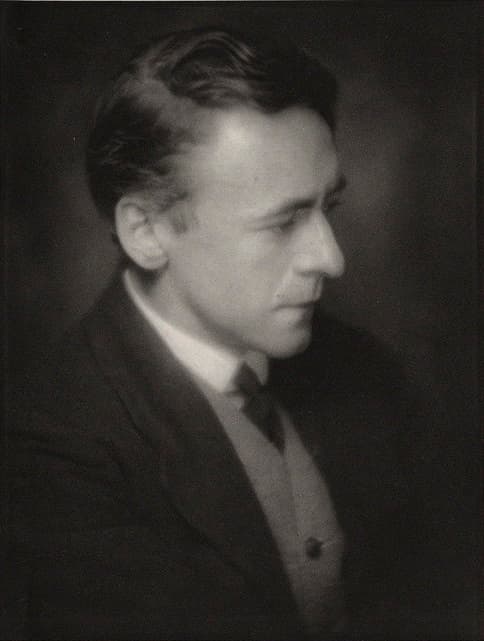Arnold Bax (1886–1953) was born in south London and raised in north London, but in his early years sought to develop a link with Ireland. In 1902, after discovering the writing of Irish writer W.B. Yeats, Arnold and his brother Clifford Bax moved to Ireland where they absorbed the strong cultural life of the country. Arnold became a noted writer and poet, publishing under the name of Dermot O’Byrne. He became a scholar of Irish legend and the Irish language.

Herbert Lambert: Arnold Bax, 1922 (National Portrait Gallery)
This Irish interest led to a number of Irish-influenced works, one of which was his 1913–14 work The Garden of Fand. He based his tone poem on one of the many legends of Cuchulain (Cú Chulainn), whom he calls ‘the Achilles of the Gael’.

J.C. Leyendecker: Cuchulain in Battle, in T.W. Rolleston’s Myths and Legends of the Celtic Race, 1911
Cuchulain is lured away ‘from the world of deeds and battles by the Lady Fand, daughter of Manannan, lord of the ocean’. At a time when his country needed him the most, Cuchulain was ensorcelled by the enchantments of an immortal woman. Cuchulain’s wife, Emer, went directly to the Lady Fand for the return of her husband. In the end, Fand renounces human love and her father separates the lovers with his Cloak of Forgetfulness, so that ‘the memory of each might be utterly blotted out from the mind of the other’.
That’s the legend, but what Bax sets is the background to all this. As he states at the outset, ‘The Garden of Fand is the sea’. He opens with a sound of ‘an enchanted Atlantic’, calm in its other-worldly manifestation. A small ship, leaving Ireland behind, heads for the sunset. Caught up in an immense wave, the little craft is stranded on the shore of Fand’s miraculous island. The voyagers are caught up in the unending dance, ‘unceasing between the ends of time’, until they are forever claimed by Fand’s song of immortal love. The dancing and revelry continue until the sea rises and overcomes the island. The immortals ride the waves in rapture, continuing their unending festivities, while all the luckless mortals are lost to the depths. As twilight comes, ‘the sea subsides, and Fand’s Garden fades out of sight’.
The piece is in a 3-part form where Fand’s song of immortal love (flute and cor anglais) forms the centre section.
Arnold Bax: The Garden of Fand (Royal Scottish National Orchestra; David Lloyd-Jones, cond.)
Bax had his training at the Royal Academy of Music in London, entering it when he was 17. His Irish influence comes through in the story he uses, but his music is purely English. We can look to W.B. Yeat’s poem The Secret Rose for the roots of this story:
… and him
Who met Fand walking among the flaming dew
By a grey shore where the wind never blew,
And lost the world and Emer for a kiss.
W.B. Yeats: The Secret Rose (1897)

W.B. Yeats: The Secret Rose, London: Lawrence and Bullen, 1897
Bax wrote the first versions of The Garden of Fand as a piano score while living in Dublin in 1913 or 1914; its first performance was with the Chicago Symphony Orchestra under Frederick Stock on 29 October 1920. The British premiere was over a year later, conducted by the young Adrian Boult, and the work was vigorously supported by Thomas Beecham.
Bax called this seascape the last of his Irish music. He was fascinated by the sea and in his autobiography says that he ‘spent more and more time alone in places lorded by the Atlantic’. He captures the movement of the waves, the undertow, and ‘the interplay of the associated legends are portrayed through evocative shifting patterns of superimposed figuration on woodwind and strings, a technique which Bax developed from a study of the music of Debussy’. The influence of Debussy is strong and this work demonstrates the first realization of Bax’s mature impressionistic style and is considered one of Bax’s finest works.
For more of the best in classical music, sign up for our E-Newsletter
